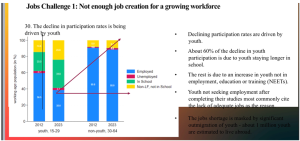
By Edem Mayford Kofi YEVUTSEY
Data is far from a new buzzword; its role in decision-making has been recognized for centuries. However, the demands of modern business, today’s intensely competitive markets and emerging trends have made it more valuable than ever.
The extent to which a company’s decisions and business processes are guided by data often determines whether it thrives or folds. According to the McKinsey Global Institute, data-driven organizations are 23 times more likely to acquire customers, 6 times as likely to retain customers and 19 times as likely to be profitable.
Data-driven companies base most of their decisions, actions, and strategies on insights drawn from facts, rather than relying solely on intuition or guesswork. This does not mean that instincts have no place—after all, even a broken clock is right twice a day—but data-driven organizations aim to be right most of the time, not just occasionally. Building such an organization should be a strategic priority for business leaders. Below are some fundamental steps towards becoming truly data-driven.

A business cannot be data-driven without data, and data cannot exist if it is not collected and stored. The first step, therefore, is for companies to thoroughly analyze their operations, identify all possible sources of information, and implement processes to capture all relevant “collectable” data. Even companies that consider themselves data-driven often limit data collection to their current needs – a risky approach.
Consider a high-end boutique that collects customer information only at the point of sale, whether in-store or online. This may include demographics, purchase details, payment information, sales per customer, feedback, behavioural insights, and staff performance data. While useful, this approach overlooks potential customers who browse but do not make a purchase or customers who visit the physical shop and walk out without buying an item.
If the proportion of such visitors rises—from 10percent three years ago, to 20percent two years ago, to 30percent this year—it could signal that the boutique’s stock no longer matches current trends. Competitors might be capitalizing on insights from data the boutique fails to collect. By the time the boutique recognizes the gap, it might need years of new data before useful trends emerge. This is why companies must think beyond present needs when deciding what data to collect.
To execute this first step effectively, companies must make data collection simple and data storage affordable. Fortunately, advances in IoT devices, smart sensors, computer vision, CRM tools, social analytics, AI, machine learning, and other digital solutions have made gathering information much easier. Similarly, the wide range of cloud storage options available today has driven down costs. In our boutique example, instead of hiring staff to manually count visitors (an inaccurate and costly approach), smart sensors and computer vision tools can provide more precise data at a lower cost. Businesses should leverage such technologies to make data collection and storage efficient and cost-effective.
The third step is to ensure the right people are in place to design and execute the organization’s data strategy. In large companies, a Head of Data or Chief Data Officer should lead implementation and oversee governance. The data team might include Data Engineers (to design and maintain data pipelines), Database Administrators (to manage and optimize databases), Cloud Engineers (to design cloud storage platforms), Data Analysts and BI Specialists (to analyze and visualize insights), Data Scientists and Machine Learning Engineers (to create predictive models and decision-support systems), and Data Security Specialists (to safeguard systems and manage access controls).
The composition of this team will vary by company size, data volume, and operational needs. Some roles can be combined, and certain functions, such as governance, may be outsourced to specialized firms.
The fourth step is recognizing that becoming data-driven is a strategic decision that must originate at the highest level. The board’s vision and leadership should guide the transition, starting with an honest assessment of the organization’s current state. Are decisions based on data? Is the company proactive or reactive? The answers inform a data strategy that shapes recruitment, infrastructure investment, and cultural change. The data department, with board support, should drive the adoption of data practices across all departments, ensuring data-based decisions become part of the organizational culture.
You may notice that the steps outlined in the previous paragraph appear in reverse order from the flow of the article. This is deliberate. Storytelling is an important part of the data science world, and the writer chose a reversed narrative style to present a more compelling story that graduates from an operational conundrum to a strategic solution.
As we move into a future powered by Artificial Intelligence (AI), companies must recognize that AI is built on a foundation of data. AI will enable companies gain insights into data in seconds, facilitating business at the speed of thought. Becoming data-driven should not be an option, it should be the strategy.
>>>the writer is a global trade and investment strategist with 15 years’ executive leadership; MBA (Finance) and IBM-certified Data Scientist, fusing business vision with expertise in data science, analytics, machine learning, and AI engineering. He can be reached via https://www.linkedin.com/in/africatrade/
The post Building a data-driven organization – Where companies should start appeared first on The Business & Financial Times.
Read Full Story















Facebook
Twitter
Pinterest
Instagram
Google+
YouTube
LinkedIn
RSS